by James | Dec 6, 2017 | Remembrance
Today we commemorate the 100th anniversary of the death of Thomas Wand of Dunsby and the 2nd/5th Battalion Lincolnshire Regiment.
Thomas was born in Dunsby in the summer of 1894 to John Joseph Wand, born in Morton, a farm labourer and his wife Mary Ann Grange Vickers born in Bourne. They were married in 1891 and lived in Bulby before settling in Dunsby. They had 13 children although sadly they lost 3 of them before 1911.
- George William Wand, 1891, Bulby
Beatrice Wand, 1892, Bulby
Thomas Wand, 1894, Dunsby
Gertrude Wand, 1896, Dunsby
Eliza Wand 1897, Dunsby
Lily Wand, 1900, Dunsby
Harry Wand, 1902, Dunsby
Charles Robert Wand, 1904, Dunsby
Annie May Wand, 1907, Dunsby
Emily Wand, 1908, Dunsby
Thomas had moved away from his parents before 1911 and was living with the Haresign family in Pinchbeck working as a horseman on the farm.
Thomas enlisted into the army and was posted into the 7th Battalion Lincolnshire Regiment but at some point was posted to the 2nd Battalion Lincolnshire regiment. As the dates are not known then it is difficult to say exactly which actions Thomas was involved in other than the final action that cost him his life.
In early December 1917 the 2nd Battalion was in the line at Bourlon Wood and an extract from the Battalion Diaries describes Thomas’ last days.
3rd December 1917 – Bourlon Wood
Enemy Machine Gun fired at intervals throughout the night. We suffered 2 casualties
4th December 1917 – Bourlon Wood
Enemy activity again confined to artillery fire. In order to reduce the salient of which our line forms part, a withdrawal was carried out to the Flesquires Line. Pack ponies and limbers were brought up and ammunition and stores were removed before the withdrawal commenced. The withdrawal was made from the left by platoon. One platoon remained behind in the centre company’s frontage to cover the withdrawal. The first company commenced the withdrawal about 9:45pm and it continued in good order platoons moved independently across country to Flesquieres and took up their allotted position in the Flesquieres line. The enemy seemed totally unaware of the withdrawal. There was no fire from the artillery beyond the ordinary routine firing on the right. The withdrawal was concluded in good order, without casualties and dispositions taken up at Flesquieres as follows.
The existing trenches N and NW of Flesquieres between the limits K.18b.2.2 and K.17 d.8.6 were held by A and B companies with C and D companies in support in the support line about K.24 Battalion HQ in dugout K.24.a.1.b.
No signs of the enemy following up were observed until about 3.0pm when motor lorries were seen in Fontaine-Notre-Dame and small bodies of enemy were seen in neighbourhood of Bourlon Wood. Our front was with two Companies of the 2/4th Lincolns. At night we commenced digging.
5th December 1917 – Flesquieres
A new front line trench running from K.18.a.70.45 to K.17.b.8.5 thus bringing the front line up to the advanced posts of the 1/6th london Regiment on our left. On the right were the 2/5th Leicester Regiment. This new front line trench was dug to 3’6 and occupied by seven lewis gun posts. During the digging the enemy shelled continuously inflicting bout a dozen casualties. Captain H N Newsum was sent down suffering from shell gas.
6th December 1917 – Flesquieres
3.0pm – Our outpost line fell back on our front line trenches and an enemy attack developed. The brunt of the attack fell on the 2/5th Leicester Regiment on our right and no enemy came up against our trenches although we were able to bring fire to bear on those advancing against the right Battalion. Enemy shelling was heavy and we sustained some twenty casualties.
Patrols were sent out to battalion on the right and left to keep in touch. Communication difficulties owing to enemy shelling.
8.0pm – Work was continued on the new front line commenced last night and a new communications trench commenced from K.18a.3.5 to K.18c.2.8. This trench was dug 3 feet wide and 3’6 deep during the night. Fighting patrols were sent out during the night to prevent the enemy reconnoitring our line and to prevent him from digging in near our line. Harassing fire by artillery and machine guns was arranged during the night to prevent the enemy digging.
Lieut Garrad sent down suffering from effects of shell gas.
Although no men killed or missing are mentioned specifically, we have to assume that Thomas Wand was killed during this period, most likely from shelling by the enemy either during the withdrawal or the artillery fire on the digging parties.
Commonwealth War Graves:
In memory of Thomas Wand, 21543 2nd./5th battalion Lincolnshire Regiment who died on 6th December 1917. Son of J J Wand of Dunsby Fen, Bourne, Lincs. Remembered with honour, Orival Wood Cemetery, Flesquieres.


Lest we forget.

by James | Dec 2, 2017 | Remembrance
On this day, 2nd December 2017, we remember three of our local men that lost their lives in the Great War exactly 100 years ago..
Private Ernest Henry Rudkin
Kirkby Underwood – 2nd Battalion Royal Berkshire Regiment
Lieutenant Rupert Hardy Parker
Morton – 2nd Battalion Lincolnshire Regiment
Private Walter Blankley Harby (Scarborough)
Rippingale – 2nd Battalion Lincolnshire Regiment
The Battle of Passchendaele was, by this time in 1917, officially over. The original gains during this battle were largely lost and the lines had stagnated. Major actions were officially finished for the winter but the enemy held a superior position on the Passchendaele ridge. This position was at the junction of the 8th and 32nd Brigades and allowed the enemy to place enfilade fire into the British defensive line. The men 8th and 32nd divisions, which included our three local men in the 24th Infantry Brigade, had been previously been given orders and had been training for the planned action that was to take place on the night of the 1st / 2nd December. The plan was to attack in full moonlight, without a creeping barrage, surprise the enemy and push them back from their superior position, thus ensuring that our Divisions could hold a slightly better defensive line in preparations for new actions in the spring of 1918.
Much conjecture and debate has been given to this almost forgotten action, which it could be argued was of very little tactical merit and is now known as “The Moonlight Massacre”.
The story of that night viewed from the perspective of the 2nd Lincolnshire. The 2nd Battalion, had seen action as part of the Battle of Passchendaele and on the 16th August 1917 they were removed from the front line following heavy losses at the Battle of Langemarck where only three hundred men remained fit for active service. September, October and half of November saw the battalion in trenches around Basseville and Warenton or in support or divisional reserve in the region. Officially the battle of Passchendaele ended in November 1917 with the front returning back to its previous routine of trench life, patrols, shelling and sniping. Although one final mass action had already been planned and was still carried out.
On the 1st December C Company 2nd battalion Lincolnshire Regiment paraded at 3:15pm and set out for the trenches near Passchendaele. The only way to the front line was by a duck board track across deep clinging mud. The enemy guns had found their mark on the track and only about 20 men reached the front line to take up the two posts on the left battalion front. An hour later the remaining three companies, detailed as assault troops started moving up. It shows the terrible nature of moving up in the fact that it took the first company 5 hours to reach the front of the duck board track. The first company was in position by 10pm and the last company by 12:20am.
The three companies started to attack at 1:55am (2nd December 1917) and immediately were spotted by the enemy who set up heavy machine gun fire. Before their own outpost line was reached every officer of the three companies became a casualty. The advance stopped about 30 yards from the enemy’s front trench and the battalion dug in. They were relieved from this position by the 8th Rifle Brigade and moved back to Camp St. Jean.
In this attack casualties were heavy. Captain A Cowe (Medical officer), Lieutenant Rupert H Parker and 16 other ranks killed. 2nd lieutenants Griffin (Later died of wounds), Eliot, Sowerby, Joyce, Green, Graves, Grant and Perkins along with 64 other ranks wounded. 25 other ranks were missing.
Lieutenant Rupert Hardy Parker was killed whilst leading his company in this ill fated action on the 2nd December 1917, where the men were asked to attack on a moonlight night, in snow and towards an heavily defended position.
Lieutenant Rupert Hardy Parker
Rupert was the only son of Charles John Ernest Parker a Gentleman of Beaconfield House, Harrowby, Grantham and his wife Louisa Dempsey. Rupert’s father was a former Captain in the 3rd battalion Lincolnshire regiment, His Grandfather was a former Lt Col of the South Lincs Militia, His Gt Grandfather Lt-Col, deputy Lord Lieutenant and High Sheriff of Lincolnshire.
By the time of the war the family home was Ludshott House, Grayshott, Hampshire.
Rupert was educated at Wellington College, Crowthorne, Berkshire and an undergraduate of Christ Church College, Oxford and was due to start before joining the army at the outbreak of war.
Rupert was accepted on probation as a second lieutenant in the 3rd Battalion Lincolnshire regiment on 21st October 1914. After training he was transferred to the 2nd Battalion Lincolnshire regiment arriving in France on the 20th February 1915.
Rupert finally completing his probation in March 1915 and was confirmed as a second lieutenant.
During 1915 Rupert was twice wounded at Neuve Chapelle and Fromelles.
Rupert obtained a regular commission in June 1916 before his Battalion were to form part of the history of the Third Battle of Ypres, commonly known as the Battle of Passchendaele.
Lieutenant Rupert Hardy Parker, 2nd Battalion, The Lincolnshire Regiment, is remembered with honour on the Tyne Cot Memorial to the missing which is located 9 km north east of Ieper (Ypres), Belgium.
Panel Ref: 35 to 37 and 162 to 162A
Rupert is also commemorated on the Morton memorial and also on a family memorial plaque in St Wulfram’s Church, Grantham.
Private Ernest Henry Rudkin
Ernest Rudkin was born in 1891 in Morton near Bourne, Lincolnshire to Henry James Rudkin, a waggoner and his wife Mary Ann Wrighton. Ernest was the eldest of their 7 children, Bertie, Arthur, Edith, Florence, Albert and Cedric all being born as the family moved around the area as Henry found work as a Horseman and Waggoner on farms in Morton, Witham on the Hill, Corby Glen, Swinsted and eventually the family settled at Kirkby Underwood.
By 1911 Ernest was now working as a waggoner on a farm in Burton Coggles and was living with the Mason family. In 1914 Ernest married Sophia Osbourne and their son Jarvis was born in the spring of 1915.
Ernest along with his younger brother Bertie both undertook their duty to their country and sadly the family learned of the death of Bertie in September 1916. He had been serving with the 1st battalion Lincolnshire Regiment.
Ernest was now serving with the 2nd Battalion Royal Berkshire Regiment and in the early hours of 2nd December, 2 Km to the North of Passchendaele in Belgium, Private 37869 Ernest Henry Rudkin of 2nd Battalion Royal Berkshire Regiment was amongst the 35 Other Ranks killed in action.
The letter to his parents received in January 1918 from 2nd Lieut Durnford said he had died instantly as a result of Shell fire and buried soon after.The location was not recorded.He further stated that he had died in action gallantly doing his duty.A classic style of letter sent to many families at that time.Ernest was the eldest son of the family living in Kirkby Underwood at that time but they had already lost their 2nd Son Bertie some 15 months earlier.Ernest Henry also left a wife and a 3 year old infant boy. Ernest has no known grave but is remembered on the Tyne Cott Memorial, in Kirkby Underwood Church and on the family grave in Little Bytham Churchyard.
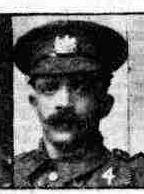
He is also remembered today by his family members who are determined to never forget what our Service Ancestors were asked to do so many years ago and how well they did it. Thanks to Peter Reichelt for information about Ernest.
Private Walter Blankley Harby AKA Walter Scarborough
Walter Harby was born in 1897 in Wandsworth London to Charlotte Elizabeth Harby of Pickworth Lincolnshire. Charlotte later married Thomas Scarborough, a shepherd from Brauncewell near Sleaford in 1899 and moved to Dowsby. The family left Dowsby after the birth of son Harold and moved to Aslackby where son Joseph was born, the family eventually moving to Rippingale.
In December 1915 Walter attested to the Army Reserve and was later mobilised into 3rd battalion Lincolnshire Regiment in July 1916. After training he was posted to the 2nd Battalion prior to them embarking for France on the 18th November 1916.
Walter was killed in action and buried in the field on 2nd December 1917. We can only assume that the burial place was later destroyed by later fighting as Walter is now commemorated on the Tyne Cot memorial to the missing.


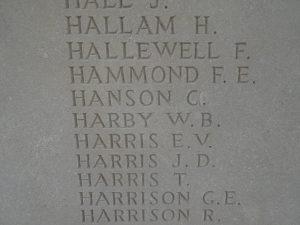
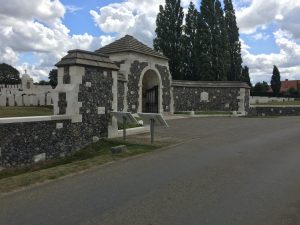
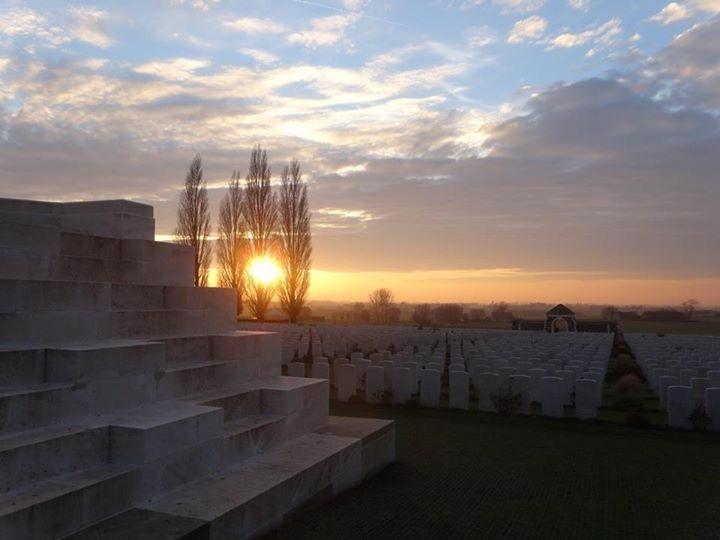
by James | Dec 2, 2017 | Remembrance
On 2nd December we remembered Rupert Hardy Parker, Gt Grandson of Lt Col William Parker of Hanthorpe House, who was killed in an action 100 years ago on this day in 1917.
Rupert was the only son of Charles John Ernest Parker a Gentleman of Beaconfield House, Harrowby, Grantham and his wife Louisa Dempsey. Rupert’s father was a former Captain in the 3rd battalion Lincolnshire regiment, His Grandfather was a former Lt Col of the South Lincs Militia, His Gt Grandfather Lt-Col, deputy Lord Lieutenant and High Sheriff of Lincolnshire.
By the time of the war the family home was Ludshott House, Grayshott, Hampshire.
Rupert was educated at Wellington College, Crowthorne, Berkshire and an undergraduate of Christ Church College, Oxford and was due to start before joining the army at the outbreak of war.
Rupert was accepted on probation as a second lieutenant in the 3rd Battalion Lincolnshire regiment on 21st October 1914. After training he was transferred to the 2nd Battalion Lincolnshire regiment arriving in France on the 20th February 1915.
Rupert finally completing his probation in March 1915 and was confirmed as a second lieutenant.
During 1915 Rupert was twice wounded at Neuve Chapelle and Fromelles.
Rupert obtained a regular commission in June 1916.
Rupert, now a Lieutenant in the 2nd Battalion, saw action as part of the Battle of Passchendaele. On the 16th August 1917 the 2nd Battalion, Lincolnshire Regiment were removed from the front line following heavy losses at the Battle of Langemarck only three hundred men remained.
September, October and half of November saw the battalion in trenches around Basseville and Warenton or in support or divisional reserve in the region.
Officially the battle of Passchendaele ended in November 1917 with the front returning back to its previous routine of trench life, patrols, shelling and sniping. Although one final mass action had already been planned and was still carried out.
On the 1st December C Company paraded at 3:15pm and set out for the trenches near Passchendaele. The only way to the front line was by a duck board track across deep clinging mud. The enemy guns had found their mark on the track and only about 20 men reached the front line to take up the two posts on the left battalion front. An hour later the remaining three companies, detailed as assault troops started moving up. It shows the terrible nature of moving up in the fact that it took the first company 5 hours to reach the front of the duck board track. The first company was in position by 10pm and the last company by 12:20am.
The three companies started to attack at 1:55am (2nd December 1917) and immediately were spotted by the enemy who set up heavy machine gun fire. Before their own outpost line was reached every officer of the three companies became a casualty. The advance stopped about 30 yards from the enemy’s front trench and the battalion dug in. They were relieved from this position by the 8th Rifle Brigade and moved back to Camp St. Jean.
In this attack casualties were heavy. Captain A Cowe (Medical officer), Lieutenant Rupert H Parker and 16 other ranks killed. 2nd lieutenants Griffin (Later died of wounds), Eliot, Sowerby, Joyce, Green, Graves, Grant and Perkins along with 64 other ranks wounded. 25 other ranks were missing.
Lieutenant Rupert Hardy Parker was killed whilst leading his company in this ill fated action on the 2nd December 1917, where the men were asked to attack on a moonlight night, in snow and towards an heavily defended position.
Lieutenant Rupert Hardy Parker, 2nd Battalion, The Lincolnshire Regiment, is remembered with honour on the Tyne Cot Memorial to the missing which is located 9 km north east of Ieper (Ypres), Belgium.
Panel Ref: 35 to 37 and 162 to 162A
Rupert is also commemorated on the Morton memorial and also on a family memorial plaque in St Wulfram’s Church, Grantham.
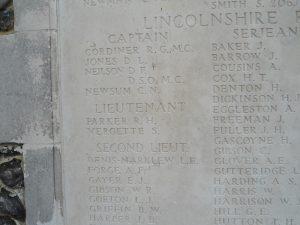


by James | Oct 29, 2017 | Remembrance
Today we commemorate the 100th Anniversary of the death of Thomas Kettle of Bourne and also of the 15th battalion Sherwood foresters.
Thomas was born in 1884 in Bourne to William Kettle and agricultural Labourer born in Little Bytham and his wife Mary Sandall born in Morton. They were married in September 1866 in Bourne and had 11 children, Thomas being the youngest.
John William Kettle, 1867, Bourne
Sarah Ann Kettle, 1869, Bourne
Edward Kettle, 1871, Bourne
Arthur Albert Kettle, 1872, Bourne
Mary Elizabeth Kettle, 1874, Bourne
Richard Partridge Kettle, 1876, Bourne
Edward Kettle, 1876, Bourne
Charles Robert Kettle, 1877, Bourne
Rebecca Kettle, 1879, Bourne
Walter Kettle, 1882, Bourne
Thomas Kettle, 1884, Bourne
William passed away before 1890 leaving Mary with the large family. By 1891 Thomas can be found living with his mother in Bedehouse Bank, Bourne, with 4 of his siblings. Mary was supporting them by working as a washwoman and 15 year old Edward working as a labourer.
Thomas has not been found on the 1901 census and by 1911 he is working as a labourer on a farm at Long Sutton and living with the Taylor family.
Thomas’ war records have not been found and like 60% of all WW1 records they are believed to have been destroyed in the Blitz when the warehouse containing them was bombed.
It is known that Thomas enlisted in Lincoln and was posted to the 15th Battalion Sherwood Foresters (Notts and Derby Regiment). Thomas was not entitled to a 1915 star and so we can assume that he first saw service abroad with the battalion after 1915. The 15th Battalion was a bantam battalion and took men who were 5ft 3inches and under. This normally meant that the men posted to the Battalion were physically very strong and usually came from a labouring or mining background.
As we are not sure when Thomas was posted abroad we can only look at his last month with the regiment with any certainty that he was part of the actions that are described in the Battalion Diaries.
Although the 15th battalion were ordered to Egypt in late 1915, this was cancelled and their first overseas posting was in February 1916 to France where the Battalion fought in the Battle Somme.
We take up the story on the 1st October 1917 in the middle of the 3rd Battle of Ypres also known as the battle of Passchendaele. The Battalion had spent most of the year in the sector near Peronne, previously being in are Arras area.
1st October 1917 – Aizecourt Le Bas
Battalion conveyed to Peronne in Motor Lorries. Transport moving by road.
2nd – 3rd October 1917 – Peronne
Resting and refitting,. Battalion entrained at Peronne at 12 midnight 23rd inst. en route for XVII Corps area and detrained at Arras at 4-30am. 4th inst. proceeding by march route to billets at Warlus. Part of the battalion transport under command of 2nd Lieut R.T Wright. proceeded by road halting on the night of the 3rd inst at Bapaume and continuing march on the 4th inst. arrived at Warlus at 12 noon.
3rd to 12th October – Warlus
Re-organization of Companies and Battalion training.
13th October – Warlus
Battalion (Less “Z” Cmpany.) entrained at Arras Station at 12-54pm and detrained at Cassel at 8-30pm marching to billets at Arneke.
Ltr “Z” Company entrained at Arras at 8-54pm and detrained at Cassel at 3am 14th inst.
15th October – Arneke
Battalion (Less transport) entrained at Arneke at 12 noon and detrained at Proven about 2-30pm marching to D4 camp
16th October – Proven
Entrained to Proven at 12 noon and detrained at Elverdinghe.
Battalion relieved 1st Scots Guards at Rugby Camp. Transport moved by road and occupied camp near Woeston.
17th to 20th October – Elverdinghe
Reconnaisance of line South of Houthulst Forest preparatory to attack.
Furnishing of working parties to assist in preparing forward gun positions.
20th October
At 5pm Battalion moved to Gouvy Farm near Boesinghe
21st October
Battalion moved to assembly positions as supporting Battalion to 105th Brigade in general attack on morning of 22nd inst on enemy positions South of Houthulst Forest.
22nd October
Operations South of Houthulst Forsest
Casualties from 21st to 23rd
Killed – 1 officer, 15 other ranks
Wounded – 1 officer, 160 other ranks
Missing – 1 officer, 20 other ranks
24th October
Relief of Battalion by 19th Durham Light Infantry completed at 3am Companies moved out independantly to billets at Larry Camp near Elverdinghe.
25th to 28th October – Elverdinghe
The Battalion relieved 5th Border Regiment in right sector Divisional Front by 7-30pm
Enemy very quiet whilst relief was taking place. Between 9pm and 11pm enemy put down a strong defensive barrage close behind our forward line, remainder of night was quiet.
30th October
Casualties 1 officer and 4 other ranks killed. 1 officer and 14 other ranks wounded.
At 4am enemy opened heavy artillery fire on the ground immediately behind our front line, developing in intensity at dawn. About 6am several of the enemy were seen running about in Wood East of Marechal House. Several were knowcked out by snipers at Ltr. “X” Company.
Situation quietened down by 8am and remainder of day fairly calm.
31st October
Quiet on the whole. Occasional heavy bursts of artillery fire on Battalion H.Q. and support positions. From 4-30pm onwards the enemy sent over constant streams of gas shells on our back areas.
Thomas Kettle was killed in action on the 29th October and we have to assume killed during the artillery barrage in the late evening on that night.
Commonwealth War Graves Commission:
In memory of Private Thomas Kettle, 50186, 15th Battalion, Sherwood Foresters (Notts and Derby Regiment) who died on 29 October 1917
Remembered with honour, Tyne Cot Memorial.


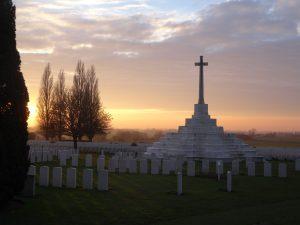

by James | Oct 9, 2017 | Remembrance
Today we remember George Edward Hunt, another of our villagers who never returned from The Great War.
George was Born in Stainfield in 1895 and was the son of farm labourer James Hunt and his wife Mary Stokes.
George joined the 5th Battalion Lancashire Fusiliers a battalion that arrived in Le Havre in March 1917.
George was killed in action on the 9th October 1917 during the third phase of the third battle of Ypres (Passchendaele).
In Memory of Private George Edward Hunt, 39301, 3rd/5th Battalion Lancashire Fusiliers who died on 9 October 1917 Age 23.
Son of James and Mary Hunt, of Stainfield, Bourne, Lincs.
Remembered at the Tyne Cot Memorial
Panel Ref: Panel 54 to 60 and 163A
George is also remembered on the Haconby War Memorial.


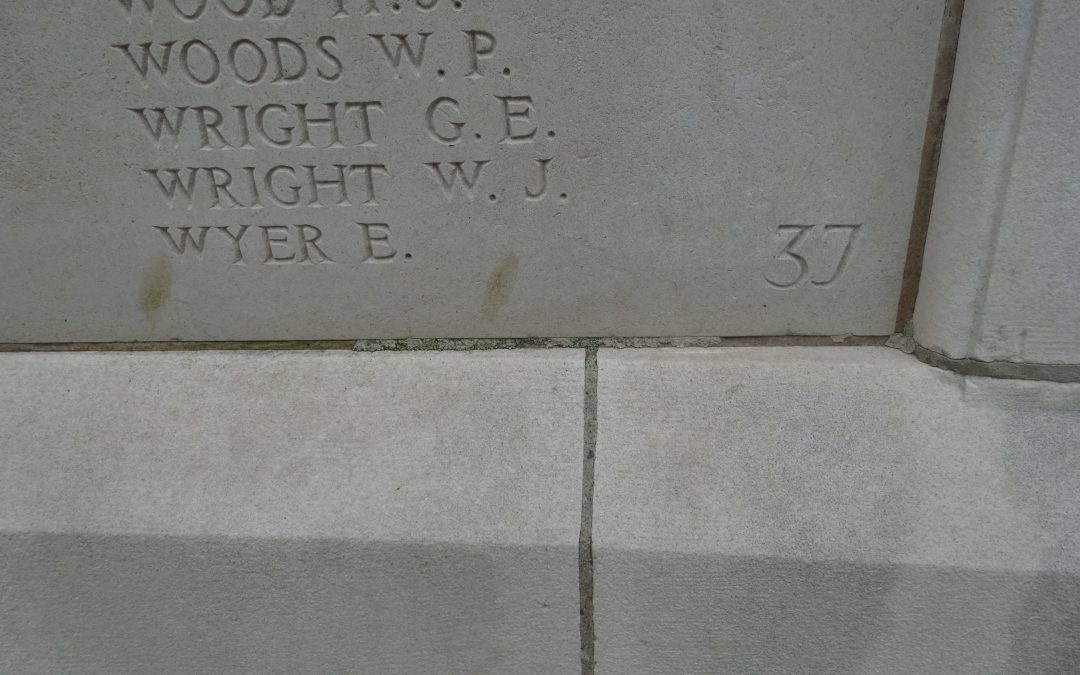
by James | Oct 4, 2017 | Remembrance
Today, 4th October, we remembered Haconby man Edmund Wyer who was killed on this day 100 years ago in 1917.
Edmund was the son of William and Sarah Ann Wyer of Haconby and was one of their 10 children.
Edmund was a farm labourer before war broke out he was one of nine men from our parishes that had enlisted in Kitchener’s Army before October 1914.
Edmund joined the 8th Battalion Lincolnshire regiment and embarked from Folkestone in September 1915. Following leave back to the UK in January 1917, Edmund was wounded in april 1917. Rejoining his battalion in May 1917, that year saw Edmund take part in the 3rd battle of Ypres (Passchendaele) where he was subsequently killed in action on the 4th October.
The story of Edmund’s family during the war is a very sad one with seven cousins all being killed in action, including Edmund’s two brothers.
In Memory of Private Edmund Wyer, 10912, 8th Battalion Lincolnshire Regiment who died on 4 October 1917.
Remembered with Honour Tyne Cot Memorial
Panel Ref: 35 to 37 and 162 to 162A
Edmund and his two brothers are also remembered on the Haconby memorial.
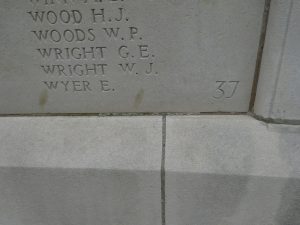























Recent Comments